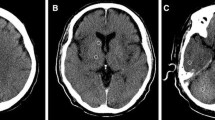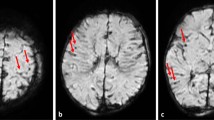Abstract
A man and a woman were found dead in the same car with a burned coal briquette. The cause of death of the woman was assigned to acute carbon monoxide (CO) poisoning without difficulty based on typical findings associated with this condition, including elevation of carboxyhaemoglobin (COHb). However, the man had an unremarkable elevation of COHb and a higher rectal temperature compared to that of the woman. Postmortem computed tomography (PMCT) revealed ambiguous low-density areas in the bilateral globi pallidi. Further analysis by postmortem magnetic resonance (PMMR) imaging showed these lesions more clearly; the lesions appeared as marked high signal intensity areas on both the T2-weighted images and the fluid-attenuated inversion recovery sequences. A subsequent autopsy revealed signs of pneumonia, dehydration, starvation, and hypothermia, suggesting that the man died from prolonged CO poisoning. Both globi pallidi contained grossly ambiguous lesions, and a detailed neuropathologic investigation revealed these lesions to be coagulative necrotic areas; this finding was compatible with a diagnosis of prolonged CO poisoning. This case report shows that postmortem imaging, especially PMMR, is useful for detecting necrotic lesions associated with prolonged CO poisoning. This report further exemplifies the utility of PMMR for detecting brain lesions, which may be difficult to detect by macroscopic analysis.


Similar content being viewed by others
Data availability
Not applicable.
References
Weaver LK (2009) Clinical practice. Carbon monoxide poisoning. N Engl J Med 360:1217–1225. https://doi.org/10.1056/NEJMcp0808891
Lapresle J, Fardeau M (1967) The central nervous system and carbon monoxide poisoning. II. Anatomical study of brain lesions following intoxication with carbon monoxide (22 cases). Prog Brain Res 24:31–74. https://doi.org/10.1016/s0079-6123(08)60181-8
Beppu T (2014) The role of MR imaging in assessment of brain damage from carbon monoxide poisoning: a review of the literature. AJNR Am J Neuroradiol 35:625–631. https://doi.org/10.3174/ajnr.A3489
Jeon SB, Sohn CH, Seo DW, Oh BJ, Lim KS, Kang DW, Kim WY (2018) Acute brain lesions on magnetic resonance imaging and delayed neurological sequelae in carbon monoxide poisoning. JAMA Neurol 75:436–443. https://doi.org/10.1001/jamaneurol.2017.4618
Moon JM, Chun BJ, Baek BH, Hong YJ (2018) Initial diffusion-weighted MRI and long-term neurologic outcomes in charcoal-burning carbon monoxide poisoning. Clin Toxicol (Phila) 56:161–169. https://doi.org/10.1080/15563650.2017.1352098
Choi IS, Kim SK, Choi YC, Lee SS, Lee MS (1993) Evaluation of outcome after acute carbon monoxide poisoning by brain CT. J Korean Med Sci 8:78–83. https://doi.org/10.3346/jkms.1993.8.1.78
Lo CP, Chen SY, Lee KW, Chen WL, Chen CY, Hsueh CJ, Huang GS (2007) Brain injury after acute carbon monoxide poisoning: early and late complications. Am J Roentgenol 189:W205–W211. https://doi.org/10.2214/AJR.07.2425
Blokker BM, Wagensveld IM, Weustink AC, Oosterhuis JW, Hunink MG (2016) Non-invasive or minimally invasive autopsy compared to conventional autopsy of suspected natural deaths in adults: a systematic review. Eur Radiol 26:1159–1179. https://doi.org/10.1007/s00330-015-3908-8
Ruder TD, Thali MJ, Hatch GM (2014) Essentials of forensic post-mortem MR imaging in adults. Br J Radiol 87:20130567. https://doi.org/10.1259/bjr.20130567
Eriksson A, Gustafsson T, Höistad M, Hultcrantz M, Jacobson S, Mejare I, Persson A (2017) Diagnostic accuracy of postmortem imaging vs autopsy-a systematic review. Eur J Radiol 89:249–269. https://doi.org/10.1016/j.ejrad.2016.08.003
Roberts IS, Benamore RE, Benbow EW, Lee SH, Harris JN, Jackson A, Mallett S, Patankar T, Peebles C, Roobottom C, Traill ZC (2012) Post-mortem imaging as an alternative to autopsy in the diagnosis of adult deaths: a validation study. Lancet 379:136–142. https://doi.org/10.1016/S0140-6736(11)61483-9
Leth PM (2009) Computerized tomography used as a routine procedure at postmortem investigations. Am J Forensic Med Pathol 30:219–222. https://doi.org/10.1097/PAF.0b013e318187e0af
Bolliger SA, Thali MJ, Ross S, Buck U, Naether S, Vock P (2008) Virtual autopsy using imaging: bridging radiologic and forensic sciences. A review of the Virtopsy and similar projects. Eur Radiol 18:273–282. https://doi.org/10.1007/s00330-007-0737-4
Yen K, Lövblad KO, Scheurer E, Ozdoba C, Thali MJ, Aghayev E, Jackowski C, Anon J, Frickey N, Zwygart K, Weis J, Dirnhofer R (2007) Post-mortem forensic neuroimaging: correlation of MSCT and MRI findings with autopsy results. Forensic Sci Int 173:21–35. https://doi.org/10.1016/j.forsciint.2007.01.027
Añon J, Remonda L, Spreng A, Scheurer E, Schroth G, Boesch C, Thali M, Dirnhofer R, Yen K (2008) Traumatic extra-axial hemorrhage: correlation of postmortem MSCT, MRI, and forensic-pathological findings. J Magn Reson Imaging 28:823–836. https://doi.org/10.1002/jmri.21495
Aghayev E, Yen K, Sonnenschein M, Ozdoba C, Thali M, Jackowski C, Dirnhofer R (2004) Virtopsy post-mortem multi-slice computed tomography (MSCT) and magnetic resonance imaging (MRI) demonstrating descending tonsillar herniation: comparison to clinical studies. Neuroradiology 46:559–564
Franckenberg S, Schulze C, Bolliger SA, Gascho D, Thali MJ, Flach PM (2015) Postmortem angiography in computed tomography and magnetic resonance imaging in a case of fatal hemorrhage due to an arterio-venous malformation in the brain. Leg Med (Tokyo) 17:180–183. https://doi.org/10.1016/j.legalmed.2014.11.006
Weustink AC, Hunink MG, van Dijke CF, Renken NS, Krestin GP, Oosterhuis JW (2009) Minimally invasive autopsy: an alternative to conventional autopsy? Radiology 250:897–904. https://doi.org/10.1148/radiol.2503080421
Oliver J, Lyons TJ, Harle R (1999) The role of computed tomography in the diagnosis of arterial gas embolism in fatal diving accidents in Tasmania. Australas Radiol 43:37–40. https://doi.org/10.1046/j.1440-1673.1999.00615.x
Iwama T, Andoh H, Murase S, Miwa Y, Ohkuma A (1994) Diffuse cerebral air embolism following trauma: striking postmortem CT findings. Neuroradiology 36:33–34. https://doi.org/10.1007/BF00599191
Abe K, Kobayashi T, Shiotani S, Saito H, Kaga K, Tashiro K, Someya S, Hayakawa H, Homma K (2015) Optimization of inversion time for postmortem fluid-attenuated inversion recovery (FLAIR) MR imaging at 1.5T: temperature-based suppression of cerebrospinal fluid. Magn Reson Med Sci 14:251–255. https://doi.org/10.2463/mrms.2014-0086
Wagensveld IM, Blokker BM, Wielopolski PA, Renken NS, Krestin GP, Hunink MG, Oosterhuis JW, Weustink AC (2017) Total-body CT and MR features of postmortem change in in-hospital deaths. PLoS One 12:e0185115. https://doi.org/10.1371/journal.pone.0185115
Wischnewsky S (1895) Ein neues Kennzeichen des Todes durch Erfrieren. Bote Gerichtl Med 3:12–20
Prockop LD, Chichkova RI (2007) Carbon monoxide intoxication: an updated review. J Neurol Sci 262:122–130. https://doi.org/10.1016/j.jns.2007.06.037
Bleecker ML (2015) Carbon monoxide intoxication. Handb Clin Neurol 131:191–203. https://doi.org/10.1016/B978-0-444-62627-1.00024-X
Ernst A, Zibrak JD (1998) Carbon monoxide poisoning. N Engl J Med 339:1603–1608. https://doi.org/10.1056/NEJM199811263392206
Rodkey FL, O'Neal JD, Collison HA (1969) Oxygen and carbon monoxide equilibria of human adult hemoglobin at atmospheric and elevated pressure. Blood 33:57–65
Wittenberg BA, Wittenberg JB (1987) Myoglobin-mediated oxygen delivery to mitochondria of isolated cardiac myocytes. Proc Natl Acad Sci U S A 84:7503–7507. https://doi.org/10.1073/pnas.84.21.7503
Okeda R, Funata N, Takano T, Miyazaki Y, Higashino F, Yokoyama K, Manabe M (1981) The pathogenesis of carbon monoxide encephalopathy in the acute phase--physiological and morphological correlation. Acta Neuropathol 54:1–10. https://doi.org/10.1007/BF00691327
Kawanami T, Kato T, Kurita K, Sasaki H (1998) The pallidoreticular pattern of brain damage on MRI in a patient with carbon monoxide poisoning. J Neurol Neurosurg Psychiatry 64:282. https://doi.org/10.1136/jnnp.64.2.282
Alonso JR, Cardellach F, López S, Casademont J, Miró O (2003) Carbon monoxide specifically inhibits cytochrome c oxidase of human mitochondrial respiratory chain. Pharmacol Toxicol 93:142–146. https://doi.org/10.1034/j.1600-0773.2003.930306.x
Thom SR, Bhopale VM, Han ST, Clark JM, Hardy KR (2006) Intravascular neutrophil activation due to carbon monoxide poisoning. Am J Respir Crit Care Med 174:1239–1248. https://doi.org/10.1164/rccm.200604-557OC
Yarid NA, Harruff RC (2015) Globus pallidus necrosis unrelated to carbon monoxide poisoning: retrospective analysis of 27 cases of basal ganglia necrosis. J Forensic Sci 60:1484–1487. https://doi.org/10.1111/1556-4029.12838
Murray RR, Kapila A, Blanco E, Kagan-Hallet KS (1984) Cerebral computed tomography in drowning victims. AJNR Am J Neuroradiol 5:177–179
Bianco F, Floris R (1987) Computed tomography abnormalities in hanging. Neuroradiology 29:297–298. https://doi.org/10.1007/BF00451772
Mohan A, Lee T, Sachdev P (2014) Surviving acute cyanide poisoning: a longitudinal neuropsychological investigation with interval MRI. BMJ Case Rep 19:2014. https://doi.org/10.1136/bcr-2013-203025
Karayel F, Turan AA, Sav A, Pakis I, Akyildiz EU, Ersoy G (2010) Methanol intoxication: pathological changes of central nervous system (17 cases). Am J Forensic Med Pathol 31:34–36. https://doi.org/10.1097/PAF.0b013e3181c160d9
Renard D, Brunel H, Gaillard N (2009) Bilateral haemorrhagic infarction of the globus pallidus after cocaine and alcohol intoxication. Acta Neurol Belg 109:159–161
Daras MD, Orrego JJ, Akfirat GL, Samkoff LM, Koppel BS (2001) Bilateral symmetrical basal ganglia infarction after intravenous use of cocaine and heroin. Clin Imaging 25:12–14. https://doi.org/10.1016/s0899-7071(00)00232-1
De Smet K, De Maeseneer M, Talebian YA, Stadnik T, De Mey J (2011) Bilateral globus pallidus infarcts in ecstasy use. JBR-BTR 94:93. https://doi.org/10.5334/jbr-btr.512
De Roock S, Hantson P, Laterre PF, Duprez T (2007) Extensive pallidal and white matter injury following cocaine overdose. Intensive Care Med 33:2030–2031. https://doi.org/10.1007/s00134-007-0773-1
Miller JM, Vorel SR, Tranguch AJ, Kenny ET, Mazzoni P, van Gorp WG, Kleber HD (2006) Anhedonia after a selective bilateral lesion of the globus pallidus. Am J Psychiatry 163:786–788. https://doi.org/10.1176/ajp.2006.163.5.786
Kim DW, Im HJ, Oh J (2013) Selective injury of the globus pallidus and hippocampus in methamphetamine-induced encephalopathy. Clin Neuroradiol 23:51–53. https://doi.org/10.1007/s00062-011-0115-0
Lin YH, Huang E, Chien YL (2012) Bilateral pallidal necrosis and cardiac toxicity in a patient with venlafaxine and bupropion overdose. Am J Psychiatry 169:993–994. https://doi.org/10.1176/appi.ajp.2012.11111708
Szolics M, Chaudhry M, Ljubisavljevic M, Corr P, Samir HA, van Gorkom KN (2012) Neuroimaging findings in a case of fluoxetine overdose. J Neuroradiol 39:254–257. https://doi.org/10.1016/j.neurad.2011.10.006
Jeong JH, Kwon JC, Chin J, Yoon SJ, Na DL (2002) Globus pallidus lesions associated with high mountain climbing. J Korean Med Sci 17:861–863. https://doi.org/10.3346/jkms.2002.17.6.861
Rabitsch W, Brugger SA, Pirker W, Baumgartner C, Reiter E, Keil F, Prayer D, Hoecker P, Lechner K, Kalhs P, Greinix HT (1997) Symmetrical necrosis of globus pallidus with severe gait disturbance in a patient with myelodysplastic syndrome given allogeneic marrow transplantation. Ann Hematol 75:235–237. https://doi.org/10.1007/s002770050349
Lou M, Jing CH, Selim MH, Caplan LR, Ding MP (2009) Delayed substantia nigra damage and leukoencephalopathy after hypoxic-ischemic injury. J Neurol Sci 277:147–149. https://doi.org/10.1016/j.jns.2008.09.032
Abou Hassan OK, Karnib M, El-Khoury R, Nemer G, Ahdab-Barmada M, BouKhalil P (2016) Linezolid toxicity and mitochondrial susceptibility: a novel neurological complication in a Lebanese patient. Front Pharmacol 7:325. https://doi.org/10.3389/fphar.2016.00325
Finelli PF (1984) Bilateral hemorrhagic infarction of the pallidum. J Comput Assist Tomogr 8:125–127. https://doi.org/10.1097/00004728-198402000-00025
Michel SJ, Given CA 2nd, Robertson WC Jr (2004) Imaging of the brain, including diffusion-weighted imaging in methylmalonic acidemia. Pediatr Radiol 34:580–582. https://doi.org/10.1007/s00247-004-1155-2
Schmidt TM, Fischer R, Acar S, Lorenzen M, Heinemann A, Wedegärtner U, Adam G, Yamamura J (2012) DWI of the brain: postmortal DWI of the brain in comparison with in vivo data. Forensic Sci Int 220:180–183. https://doi.org/10.1016/j.forsciint.2012.02.022
Acknowledgments
The authors would like to thank Hiroko Abe, Yoshikazu Yamagishi, Katsura Otsuka, Kazuhiro Kobayashi, Yuriko Odo, and Miyuki Miura for their technical support. The authors also would like to thank Editage (www.editage.com) for English language editing.
Funding
This work was supported by JSPS KAKENHI Grant Numbers JP16H06242 and JP26870102.
Author information
Authors and Affiliations
Contributions
All authors contributed to the conception of this case report. Data collection and analysis were performed by Shigeki Tsuneya, Yohsuke Makino, Masatoshi Kojima, Maiko Yoshida, Takashi Kishimoto, Hiroki Mukai, and Shinya Hattori. The first draft of the manuscript was written by Shigeki Tsuneya, and all authors commented on previous versions of the manuscript. All authors have read and approved the final manuscript.
Corresponding author
Ethics declarations
Conflict of interest
The authors declare that they have no conflict of interest.
Ethics approval/consent to participate/consent for publication
The ethics committee of the University of Tokyo approved this study and permitted waiver of consent from next of kin.
Code availability
Not applicable.
Additional information
Publisher’s note
Springer Nature remains neutral with regard to jurisdictional claims in published maps and institutional affiliations.
Rights and permissions
About this article
Cite this article
Tsuneya, S., Makino, Y., Chiba, F. et al. Postmortem magnetic resonance imaging revealed bilateral globi pallidi lesions in a death associated with prolonged carbon monoxide poisoning: a case report. Int J Legal Med 135, 921–928 (2021). https://doi.org/10.1007/s00414-021-02506-1
Received:
Accepted:
Published:
Issue Date:
DOI: https://doi.org/10.1007/s00414-021-02506-1




